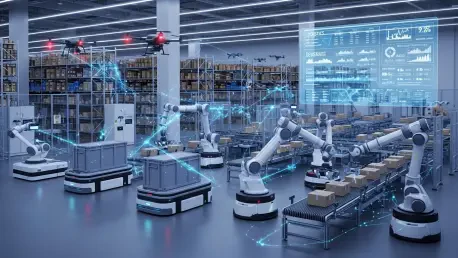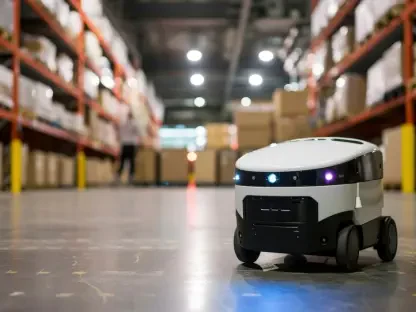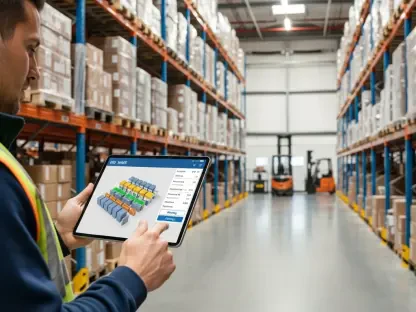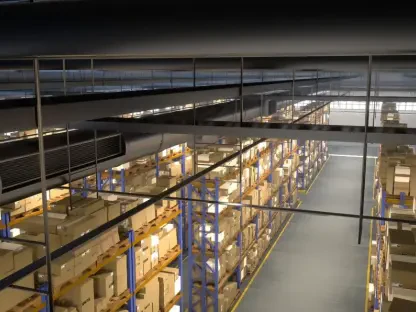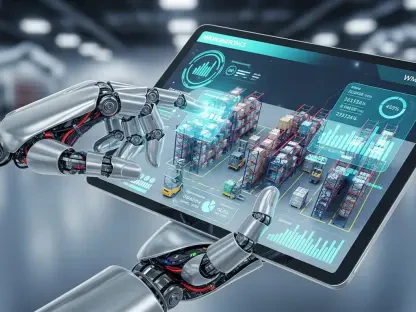Imagine a sprawling factory floor where nearly 200 robots operate in perfect harmony, seamlessly handling the production and logistics of massive excavators without any human intervention. This is not a scene from a sci-fi movie but a reality in the construction machinery sector, where intelligent logistics automation is transforming traditional manufacturing. The inefficiencies of manual processes and the rigidity of high-mix, low-volume production are being dismantled by cutting-edge technologies. This review dives into the core of this transformative technology, exploring its features, real-world impact, and potential to redefine industrial operations in heavy industries.
Core Components of Intelligent Logistics Automation
Multi-Robot Collaborative Ecosystems
At the heart of intelligent logistics automation lies the concept of multi-robot collaboration, where diverse robotic systems work together to streamline complex tasks. Mobile robot swarms handle precise material transfers through dynamic path planning, while gantry robots and collaborative robots, often referred to as cobots, tackle intricate operations. These ecosystems eliminate the need for retooling delays, ensuring continuous production even in varied manufacturing scenarios, thus enhancing operational efficiency significantly.
The significance of such systems becomes evident in their ability to adapt to real-time demands. Unlike traditional setups that falter under shifting production needs, these collaborative environments adjust dynamically, maintaining precision and speed. Heavy industries, with their often cumbersome and resource-intensive processes, benefit immensely from this adaptability, reducing downtime and boosting throughput.
AI-Driven Control Systems
Another pivotal element is the integration of AI-driven control systems, which act as the brain behind logistics orchestration. Advanced platforms like the Robot Control System (RCS) manage hundreds of automated guided vehicles (AGVs) with centimeter-level accuracy. This precision ensures materials are delivered exactly where and when needed, supporting dynamic storage solutions and smart picking mechanisms.
These systems also revolutionize inventory management by providing real-time data on material flow. Factories can now track every component from warehouse to workstation, minimizing errors and optimizing stock levels. The impact is profound, as delays caused by misplaced or unavailable parts become a relic of the past, paving the way for smoother, more predictable operations.
Integrated Data and Management Platforms
Complementing robotic and AI technologies are integrated data and management platforms, such as the Line-Side Control System (LCS) and Manufacturing Execution System (MES). These self-developed systems bridge the gap between shop-floor equipment and higher-level plant management, ensuring seamless data flow. This integration allows for enhanced oversight, enabling managers to make informed decisions swiftly.
The real value of these platforms lies in their ability to coordinate disparate elements of production. By unifying data from various sources, they provide a holistic view of operations, identifying bottlenecks before they escalate into major issues. For industries dealing with complex machinery and tight schedules, this level of coordination is indispensable for maintaining a competitive edge.
Emerging Trends in Industrial Automation
Intelligent logistics automation is riding the wave of broader industrial trends, particularly the shift toward smart manufacturing in heavy sectors. The growing reliance on robotics and AI addresses the pressing need for flexibility in high-mix, low-volume production environments. Companies are increasingly seeking solutions that can handle diverse product lines without sacrificing efficiency or incurring prohibitive costs.
Another notable trend is the push for operational agility, driven by market demands for faster turnaround times. Automation technologies are evolving to support this need, incorporating features like real-time adaptability and predictive maintenance. As these advancements continue to mature, their adoption is expected to accelerate across various industrial domains over the next few years, from 2025 onward.
The influence of these trends is reshaping the competitive landscape, compelling manufacturers to rethink traditional models. Those who embrace automation are not just keeping pace but setting new benchmarks, creating a ripple effect that encourages wider industry transformation. This momentum underscores the urgency of integrating intelligent systems into existing frameworks.
Real-World Impact in Construction Machinery
A striking example of intelligent logistics automation in action is the flagship project between a leading robotics provider and a major player in the construction machinery sector. At a state-of-the-art greenfield factory, nearly 200 robots have automated an end-to-end excavator production and logistics system. This deployment showcases how technology can address long-standing challenges in operational flexibility and efficiency.
Unique features of this project include a three-dimensional material distribution network that categorizes parts by size and type, ensuring streamlined handling. AI-driven systems provide complete visibility from warehouse to workstation, while heavy-duty carriers and lifting AGVs interact seamlessly with storage units. Such innovations have drastically reduced manual intervention, setting a new standard for digital transformation.
The implications of this project extend beyond a single factory, offering a blueprint for similar industries. By demonstrating the scalability and precision of multi-robot systems, it highlights the potential for automation to tackle complex production needs. This real-world application serves as a testament to the technology’s readiness for broader implementation.
Challenges and Barriers to Adoption
Despite its promise, intelligent logistics automation faces significant hurdles in widespread adoption. Technical challenges in scaling multi-robot systems to diverse environments remain a primary concern, as not all factories are equipped to handle such intricate setups. Integration complexities further complicate deployment, often requiring substantial overhauls of existing infrastructure.
Regulatory and market barriers also pose obstacles, with varying standards across regions impacting the pace of implementation. Additionally, the initial investment required can be daunting for smaller players in heavy industries. Ongoing development efforts aim to address these issues, focusing on modular solutions that can be tailored to different operational scales.
The path forward involves not just technological innovation but also strategic collaboration between industry stakeholders. Overcoming these limitations will require concerted efforts to standardize protocols and reduce costs, ensuring that automation becomes accessible to a wider range of manufacturers. Addressing these challenges is critical for unlocking the full potential of this technology.
Looking Ahead: The Future of Automation
The trajectory of intelligent logistics automation points toward groundbreaking advancements in robotics and AI over the coming years. Potential breakthroughs include enhanced machine learning algorithms that predict operational needs with even greater accuracy, further minimizing inefficiencies. Expansion into other heavy industries, beyond construction machinery, is also on the horizon, promising to reshape global manufacturing networks.
Societal and economic impacts are expected to be profound, with automation driving job evolution rather than elimination, focusing on upskilling workers for tech-centric roles. The long-term vision includes smarter, more interconnected factories that operate with unprecedented autonomy. Keeping pace with these developments will be essential for industries aiming to maintain relevance in a rapidly changing landscape.
Final Thoughts
Reflecting on the strides made in intelligent logistics automation, it becomes clear that this technology has already reshaped heavy industry by delivering unmatched efficiency and adaptability. The successful deployment in the construction machinery sector stands as powerful proof of concept, demonstrating what is achievable with the right tools and vision. Each component, from multi-robot ecosystems to AI-driven systems, has played a crucial role in this transformation.
Looking back, the path to this point highlights the importance of overcoming technical and systemic barriers through innovation. Moving forward, industries need to prioritize scalable solutions, investing in modular systems that can adapt to varied needs without prohibitive costs. Collaboration between technology providers and manufacturers will be key to driving this next phase of growth.
As a final consideration, attention must shift toward workforce development, ensuring that employees are equipped to handle increasingly automated environments. Initiatives for training and education in robotics and AI should be ramped up to bridge skill gaps. By focusing on these actionable steps, the industrial sector can fully harness the potential of intelligent logistics automation, paving the way for a more resilient and efficient future.
